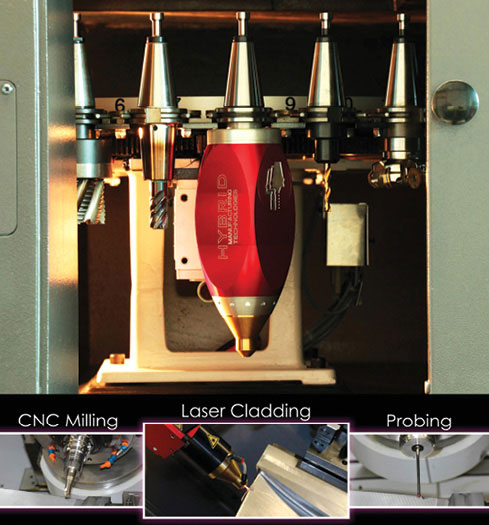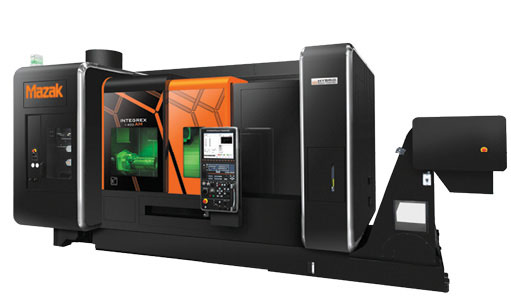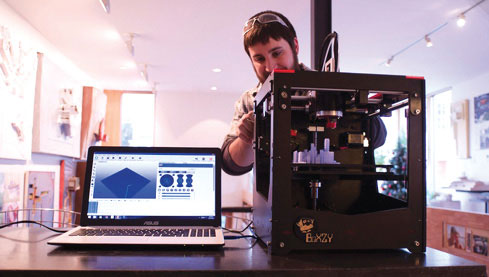
The system developed by Hybrid Manufacturing Technologies is able to complete the pictured tasks with one machine.
May 1, 2015
 The system developed by Hybrid Manufacturing Technologies is able to complete the pictured tasks with one machine.
The system developed by Hybrid Manufacturing Technologies is able to complete the pictured tasks with one machine.The concept of merging additive and subtractive techniques in one machine, a so-called hybrid 3D printer, has been around since the 1990s. Slow commercialization of the technology left hybrid 3D printers mostly off the radar of design engineers.
That may be changing as vendors from small startups like FABtotum to large, industrial players including Matsuura, Mazak, and DMG Mori are beginning to announce hybrid 3D printers, though few are on the market just yet. Combining the benefits of milling and 3D printing in one unit, these machines may break through barriers experienced by design engineers working in metals.
“Combining [additive and subtractive technologies] on the same platform and having the same set-up operation — that is a breakthrough,” says Todd Grimm, principal at additive manufacturing consulting firm T. A. Grimm & Associates.
Grimm cites Matsuura as the first hybrid 3D printer player, custom building a machine for a mold-making client near the end of the1990s. That process used powder-bed fusion as its additive technology. Since then, several other vendors including EOS and SLM Solutions have also employed powder-bed fusion for the additive piece with the addition of milling technology as the subtractive mechanism.
Advantages of Hybrid 3D Printing
Additive manufacturing (AM) carries inherent limitations in terms of surface finish, according to Grimm. The resulting metal part usually has some texture to it. “It’s not as smooth as a finely milled part,” he says. The addition of milling overcomes the two chief drawbacks of AM. First, the final product is ready to go right out of the machine — no need for a separate milling operation. And, the part has greater dimensional accuracy — always a weakness of AM alone. In-process inspection can assure quality that is otherwise impractical or impossible to evaluate.
The use of additive and subtractive technologies was once an either-or consideration for design engineers. But their marriage holds promise for design engineers who work in metals, according to Jason Jones, cofounder and CEO of Hybrid Manufacturing Technologies. Hybrid Manufacturing sells a kit that enables a computer numerically controlled (CNC) machine to be outfitted for AM.
 Mazak’s INTEGREX i-400AM melts metal powder using fiber laser heat. Cladding heads (additive manufacturing nozzles) apply the molten material layer by layer, each of which solidifies as the desired shape grows. It also provides full 5-axis milling.
Mazak’s INTEGREX i-400AM melts metal powder using fiber laser heat. Cladding heads (additive manufacturing nozzles) apply the molten material layer by layer, each of which solidifies as the desired shape grows. It also provides full 5-axis milling.“Design engineers need to know it is now possible to mix metals, which can reduce costs significantly,” says Jones. For example, assume the end product was nickel-based alloys. Normally, you would start by adding that material to Inconel. But the cost of substrates is not insignificant. Jones discovered he could just add Inconel onto a cheaper mild steel base.
“You can also use exotic materials much more easily — those sorts of things where you might just want a coating,” says Jones. “You can use those exotic materials sparingly so the technical benefits are not cancelled out by the increased manufacturing costs.”
Hybrid 3D printing has other advantages, adds Steve Griffiths, manager of Software for Additive Manufacturing at Materialise, a 3D printer manufacturer. For instance, there are more options for surface-finish levels. Also “parts will have strength and heat-resistance characteristics close to plastic injection parts,” he says.
Design engineers will be interested in the possibilities, says Grimm. With additive and subtractive working together, they will be able to design something like a metal orb with a hole on the top that you can peek into. “With AM I can make that, no problem, but I can’t get a smooth service inside the orb. But if you can hand off some additive and some subtractive operations, you can make the inside surface smooth.
“It does open the door to more production applications,” says Grimm. “That is driving interest.”
Tradeoffs
The first hybrid 3D printing technology carries the potential trade-off of excessive tool swapping, cautions Grimm. “Every time I’m doing additive [manufacturing] and I want to stop and do some milling work, I have to stop, put the tool away and then start the process again. You could potentially lose a lot of time there, so designers should be aware of that,” he says.
A new technology, called automated welding or directed energy deposition, does not have this issue. This technique, used by DMG Mori and Hybrid Manufacturing Technologies, adapts welding processes to build parts.
“It’s a little like using a hot glue gun. You’re trying to shape parts based on the metal being extruded,” says Jones. These operations are performed inside a CNC machine. “We have patented heads that fit inside the tool changer. You have multiple different drill bits and tools that you will need. Excess changeover time is not an issue.”
 Aimed at the maker market, Boxzy combines a 3D printer, CNC mill, and laser engraver, according to its Kickstarter fundraising page where it has surpassed its $50,000 fundraising goal by almost $1 million as of press time.
Aimed at the maker market, Boxzy combines a 3D printer, CNC mill, and laser engraver, according to its Kickstarter fundraising page where it has surpassed its $50,000 fundraising goal by almost $1 million as of press time.Jones believes hybrid 3D printers will be used to make prototypes to some degree. “It’s not necessarily the cheapest way to do it. Usually we would produce a plastic prototype first and then we would move on to a metal prototype.”
But he is seeing metal prototypes increase. “Designers will use hybrid printers for prototypes,” says Griffiths. For now, most design engineers are in “wait-and-see” mode. There aren’t many machines readily available yet, though blade repair is a hot area for early adopters, says Jones.
“Most design engineers should have this on their radar to start to understand this. They don’t have to rush out and do it because there is not that much availability right now,” says Grimm.
But the promise is clear: It overcomes the limitations of AM by producing a ready-to-use part that meets all specifications. The design considerations will become clearer as hybrid 3D printing takes hold.
“You can’t ignore it. You can’t safely assume that the way you design things today will work on one of these machines in the future. You don’t want to be trying to come to grips with this at the 11th hour,” says Grimm. “Be aware and start to understand the possibilities.”
More Info
Subscribe to our FREE magazine, FREE email newsletters or both!
About the Author
Lauren Gibbons Paul is a Boston-based freelance writer. Contact her via .(JavaScript must be enabled to view this email address).
Follow DE





